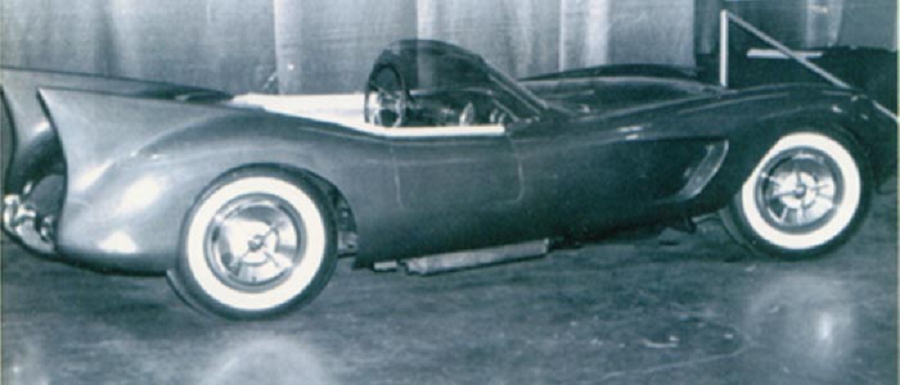

Dick Bought Supplies for his First Fiberglass (more often called “plastic”) Project From Taylor & Art Plastics in the Late 1940’s
Hi Gang….
I’m back from the California Petersen Museum trip and have returned with a tremendous number of new stories. Cars you’ve never heard of, people you’ve wanted to learn more about, and issues of interest and intrigue. More to follow in the months to come.
Today, I have the honor of introducing you to a beautiful Sports Car Special skillfully sculpted and built by Dick Williams back in the late 1950’s. I tracked down Dick thru my good friend Mike Wittman who is currently finishing off the restoration of his Meteor SR-1. More about Mike’s car in a later story.
Getting the “Calling”
Born in 1934, Dick actually got the car bug from his Mom. She was the first woman to have a Maxwell automobile in Santa Cruz, California. Not a bad legacy! Dick’s father had a 1924 Buick Sedan and both parents were proud of their son for his aptitude and interest in building his own car. Dick earned money for his first car and pushed it home from Honest Art’s Used Car Lot – for $75. It didn’t run but it was the car he wanted. It was 1948, he was 14, and his first car was a 1933 Chevrolet. So now…off to fix it up.
Getting to Glass – The First Time
He saw an ad in Hot Rod Magazine from “Taylor & Art Plastics” about an inch high from Oakland, and they offered a “Customizing Kit”. It was $10. Can’t beat that! Dick wanted to fill in the roof from his 1933 Chevy – get rid of the open roof covered with wooden slats which was the common design for roofs in those days. He got some wire screen, laid it down and made a great big mess – and it didn’t stick to the steel body. This was the early early early years of fiberglass so problems are not surprising to hear about.
Dick didn’t know better, so he called the president of the company with the question “What did I do wrong”? He got through, and had a great talk with the owner who
explained what to do differently, and sent more materials to finish the job too. This ultimately led to a lifelong friendship between Gilbert Taylor of “Taylor & Art Plastics” and Dick who kept in touch for years throughout his career.
Conceiving the Design
Dick was thinking about designing and building his own car throughout high school, and when he graduated in 1953 he was about ready to start. 1952 was the start of the “Golden Age” for building your own sports car. Initiated by Bill Tritt, Eric Irwin, and Jack Wills with their fiberglass sports cars at the November 1951 Petersen Motorama, the age of building your own sports car out of fiberglass began – and Dick was right there in California to watch the passion sweep automobile enthusiasts across the county. But….he was drafted and served in the Korean War from 1953 to 1955 – so building his dream would have to wait.
In 1955 he returned to Santa Cruz, California and bought a brand new 1955 Plymouth – delaying his dream to build his own car. And, then decided to go to the Central Technical Institute in Kansas City, Missouri to learn about electronics and pursue a career. He was in school from 1955 to 1957. His dream was delayed again.
When he finished school in 1957, Dick got married and moved from the “Missouri” side of Kansas City to the “Kansas” side, and got a job at Western Electric. So the car was delayed again for all the right reasons. But….when his first daughter, Lynda, was born on March 11th 1958 Dick decided it was now or never. He would build his car and he would get it ready for the Kansas City Custom Car Show for 1959 – almost a year from the day of his daughter’s birth. What a big effort this was going to be, and Dick was up to the challenge!
Realizing the Dream: Body Design
First the design. Had Dick pursued this dream in 1953 when he graduated from high school, the car would have undoubtedly looked much different. By 1958, sports car designs had radically changed – and so had the plans for the design of the Dick Williams Sport Special.
The first design Dick wanted to use was based on a 300 SL Mercedes and a Corvette. He liked the low slung chassis and smooth flowing long lines of both cars. He also wanted to French the headlights. At first, the rear of the body trailed off smoothly and this is how he initially molded the body of the car. But Dick liked fins – heck everyone liked fins in the late 1950’s, and his car would have them – based on the design of the 1957 Chevrolet. He added the fins after the body was molded in the late summer of 1958.
Building the Fiberglass Body – Sand Sand Sand!
Most people think of the easy way to build fiberglass cars. You have a female mold and pull a body out of the mold and voila! You have a body. Dick Williams built a fiberglass body using a male mold. Not the same process in any way, shape, or form.
First he built a wood frame with stations that resembled the shape of his car. Next, he used chicken wire and then plaster to smooth over and create the shape of the car. Next, he sanded it to a nice finish in the exact shape and size of the car, and prepared the buck to be “fiberglassed”. Preparation involved using a gallon of Johnson’s Floor Wax and waxed the plaster so that when the fiberglass cured, it would easily be “released” from the buck. Finally, he laid fiberglass on this mold/buck shape of the car and when the fiberglass cured, he pulled the body off the buck.
Now it gets hard…
Dick sanded the body for weeks, days, hours until he had a smooth paintable surface. That’s the process that Dick used to make his car body – and one that required an extraordinary amount of discipline, patience, and effort.
Dick shared the following with me, “You sculpt the shape and build a buck – a full size sample. In the 1950’s you would use plaster – today you would use foam. You lay the fiberglass on the “buck” and begin sanding – for a long time. Eventually, you have a usable body.” Dick says he wore out several 3/8” drills with sanding discs in making the body. I imagine he did! During this time, he saved the dust. This became the filler which he mixed with resin to finish any body problems during completion of the car.
He also remembered buying resin in gallon containers to help make the body. “You couldn’t buy a drum of resin at that time – I had empty cans stacked all over the place”! The “place” was his inlaws garage who were kind enough to let him build the body there in 1958.
The Donor Car:
Dick was originally going to build a car around 1953 so he – like most guys in that era – was going to use 1939-1948 Ford parts for his car. But the delay in his plans allowed him to use a more sophisticated chassis and engine – a 1950 Ford with independent front suspension and a larger engine.
Dick paid $75 for the car, and this was an interesting choice for 1958. While the independent front suspension would have been an improvement in many ways when compared to sports cars built using 1939-1948 Ford chassis and straight axles, the use of the Ford Flathead would have been unusual given the introduction of the small block Chevrolet in 1955. Dick reminded me, though, that the power to weight ratio was excellent with the car – and speed equipment was available to take it even further for anyone using a Ford V8 Flathead engine.
Hours Hours Hours – and Determination Too!
While Dick did about 90% of the work, two friends lent a hand. Glenn Birrin helped build the car. Glen was one of many friends he met while living in a rooming house and attending technical school. Another friend and roommate who helped (and who ultimately bought the car) was Norbert Borth.
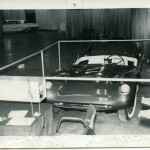
Nice Front Shot of Dick’s Car at the 1959 Show – He Was Next to the Display Booth for the Highway Patrol
After he finished the body, he started on the chassis – cutting, welding, and shortening it. After the welding began, his neighbors complained to the electric company about static on their tv, and he was shut down from building for 2-3 days. It turned out that the welding (220v) caused interference that affected the tv picture. The power company asked Dick to weld after his neighbors went to bed – which he did – and he wasn’t shut down again.
During the Kansas City Winter, he moved the car project to a larger garage that was being used as a storage area for semi trucks. It was heated inside – who could ask for a better place! During the week, Dick would work on the car starting around 6pm (after work) and finish up about 3am. Then, he would push the car outside and leave for home. Problem was, in the Winter, it snowed – so he’d have to figure out what “lump” of snow was his car the next day.
The entire project took a year – from the design and build of the body (approximately 6 months) to the completion and assembly / painting of the car. He’d come home, have dinner, leave to work on the car around 6pm and get home around 3am. He did this during the week and spent more hours per day on the weekend too. No days off to build this car. This was a 2000-3000 hour project to get this car built. Dick thinks he took his wife to a dinner and/or a movie one time that entire year. What an understanding wife 
Driving and Racing the Car:
Dick drove the car quite a bit before it was painted and finished – for about two months before the Kansas City show. He was looking for some help to “seat” the windshield, and took it to a shop near the Kansas City Stockyards – called “The Bottoms” – where two old guys worked on airplane engines and sports cars.
Dick was trying to anchor the windshield in place without any metal surround for the glass (in which he was ultimately successful in doing). These guys were in their 80’s when he met them, and they were very impressed with the car. After taking a few pictures, they told Dick…”You’ve done such a great job so far….you go home and figure it out ”. Interesting advice – or lack thereof.
So Dick returned home – and he did. He built a channel about ½ inch deep that the glass sat in, and angled the back portion of channel for the correct look of the glass, cut the body correctly, glassed up to it, and secured the glass in the channel.
Dick took his car to the NHRA dragstrip in Kansas City. During the day, he never opened the hood to let people see what it was running – and with headers it no longer sounded like a Ford Flathead V8. It was a mystery hi-powered sports car engine. He showed the engine at the end of the day and people were amazed it was a flathead. He’d beat ‘em off the line and thru most of the raceway, but they’d catch up with him at the end of the course. Pretty fast for a car which only had headers as the modification.
Dick says his “speed secret” was leaving the stock clutch in the car. Because it wasn’t an overly powerful engine, his tires hooked up every time and the Corvettes and other cars spun their tires with their powerful engines off the line. He only took the car to the drags – no race courses for this car – and not a lot of time before the upcoming car show either.
Debut: 1959 Kansas City Custom Car Show
Time was growing short. The car was completed, but not painted. In fact, Dick didn’t know it would be ready until days before the show was to start. On the day of the show he was the last car in. He had to find someone to open the doors and let him into the show to display his car.
The car show tuned out to be quite a big event. It was held in a large auditorium, and famous movie and tv stars were in attendance. In fact, Dick says he was greeted by a woman as he entered the show who was head of the GM Fashion Show. I’m trying to learn more about the show, when it was held, and where, but I have at least one good clue. Dick remembers that the “Barris of the Midwest” – Ray Farhner – was there and showed a car (or more) too. Ray was a custom car builder and in the late 1950’s, his fame and recognition was building steam. Here’s a bit more about Ray for those of you who like customs:
http://www.kustomrama.com/index.php?title=Ray_Farhner
Dick’s car was positioned near the stage and next to the Highway Patrol Booth. When the stars would leave the stage, they would come back and talk to Dick about his car. Very professional show and big – two levels in fact as Dick recalls.
The car was a big hit at the show. Now remember….Dick was from California and the folks in Kansas rarely if ever saw a car built in California style – right in the Mid-West. It was one popular car at the show and received great acclaim – who could ask for a better end of a dream?
Dick and I are not aware of any magazines that his car made it into, but it was on the front page of the Kansas City Star. I’m still looking for that newspaper, if any of you live out in Kansas or Missouri and can help.
During the show, Ray Farhner met with Dick and wanted his car to go on the custom car circuit – but Dick was already making plans to move himself and his newly expanded family back home to Santa Cruz, California. What a great success Dick had at building his dream.
Epilogue:
When I asked him what happened to the car, he shared with me the following: “I sold the car on the floor of that show in 1959 for $2600 and never saw the car again. The guy who bought it was one of my former school roommates – Norbert Borth – who actually had helped in small ways build the car. The newspaper article showing my car in the show actually shows the owner and builder as “Norbert Borth” – but that’s because he had bought it at that time. I sold the car because I did what I had intended – I built my dream. And the money helped move my family back home to California”.
In the 1960’s, Dick went looking for the car and found that Norbert had moved and brought the car to Memphis Tennessee. He had put a Chevrolet motor in it, but left it in an auto repair shop for repair and never picked it up. Unfortunately, the car was never seen again. So for those out there who are looking for cars….the Dick Williams Special was last seen in the early 1960’s in Memphis, Tennessee. Go get ‘em gang! But be sure and let us know what you find.
Dick has kept his love of cars first at hand. He is currently founder and owner of “Poli-Form” – a fiberglass company which specializes in creating and building fiberglass replicas and hot rods. You can read more about his company at his website: http://www.poli-form.com/
As for Dick’s daughter Lynda, whose birth coincided with the start of his car’s build, Dick tells me she had no say in becoming a car person. In fact, they’ve worked together in his fiberglass car business for over 30 years. Great car family Dick!
Hats off to Dick for building such a neat car and sharing such a special story with us. Dick is looking for more pictures of his car, so hopefully if he finds them I can update our story with a few more special shots of the car – so stay tuned.
Update as of November, 2010:
Dick’s car has been found! How neat for him.
I hope to post pictures and an updated story in the near future. However, the car has been dressed up as the Batmobile. While interesting, this in no way represents the history that Dick or his friends know of the car. If any evidence to the contrary is found, we look forward to sharing it with everyone. As far as we know, the car was never shown again, and was not ever exhibited as the Batmobile. Instead, it was “forgotten” like so many of the cars that we have come to appreciate. Exciting, though, that it survived.
For more information about Dick’s car, you can contact Dick Williams at (831) 234-2574.
Glass on gang…
Geoff
——————————————————————–
Click on the Images Below to View Larger Pictures
——————————————————————-
| Technical Specifications | |
| Body: | Dick Williams Sports Special |
| Designer: | Dick Williams |
| Body Work and Paint | Dark metallic blue, 20 coats of paint. Dick Williams painted his own car. |
| Upholstery | Bucket style seats, white in color. White upholstered doors and back. Carpet too. Local upholsterer in Kansas City used. |
| Hood / Doors / Trunk | Two doors were cut into body and hinged on leading edge; hood cut into front and hinged; no trunk |
| Windshield / Glass | Rear window from 1950 Chrysler, molded directly into body at base of glass. |
| Frame: | 1950 Ford, moved engine back approximately 26”-27” from center line of front end, and lowered the engine in the frame. When Dick sat in the driver’s seat – he could touch the differential/third member. Had to install a steel belly pan to cover the engine/trans and part of cockpit – the car was so low. Roads in Midwest were higher in center due to weather / snow.Dick did the welding, cutting, and shortening of the frame. |
| Suspension | Independent front suspension |
| Front Axle | 1950 Ford independent front suspension |
| Rear Axle | 1950 Ford |
| Driveshaft: (open/closed driveshaft) | 1950 Ford: Open driveshaft, shortened by Dick. |
| Brakes | 1950 Ford |
| Engine (make/year): | 1950 Ford V8 Flathead – interesting choice for 1958. |
| Speed Parts | Custom made headers – no other speed parts |
| Transmission (type/year) | 1950 Ford – Floor shifter from Corvette used with sideshift transmission |
| Carburetion | Stock 1953 Ford (one carb) |
| Displacement | 239 cu. In. |
| Horsepower (estimated) | 100 HP |
| Dashboard / Gauges | 1955 Plymouth. Molded bezels from gauges into dashboard (frenched) and attached gauges to dash from rear. |
| Steering Wheel | Unknown |
| Wheelbase | Approximately 100” |
| Track/Tread (front/rear) (distance between center line of tires) |
Stock Ford |
| Tire Size | Stock Ford |
| Wheels / Rims | 15” |
| Curb Weight | Approximately 2000 lbs |
| Top Speed (0-60) | Fast at the drags |
| Special Features: | Design features, fins, side scoop, 1949-1950 Pontiac taillights, turn signals wired into cars, tube grill for front with Harley Davidson lights welded on ends for turn signals. Frenched headlights, and used oxygen tank sides for mold to make headlight body shapes. |
- Dick Bought Supplies for his First Fiberglass (more often called “plastic”) Project From Taylor and Art Plastics in the Late 1940’s
- I’ve Always Thought The Side Scoop Was One of the Nicest Feature of the Car – Wonderfully Executed
- Great Side Shot of Dick’s Car at the 1959 Kansas City Custom Car Show
- Here the Car Body is Sanded Down and Show to the Light – Late Summer 1958
- What Magnificent Fins on the Dick Williams Special – Not Many Were Made Like This Back in the Day
- Great Picture of Car From Rear – You Can Really See Those Fins Now!
- Nice Front Shot of Dick’s Car at the 1959 Show – He Was Next to the Display Booth for the Highway Patrol
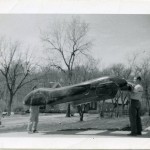
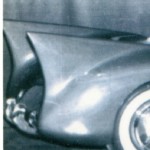
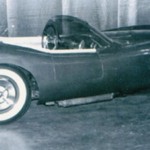
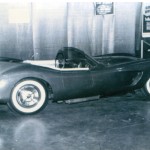
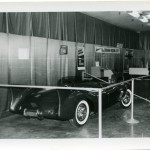

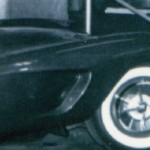
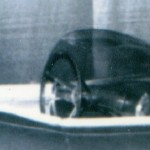
I don’t think he would mind if I mention that Dick Williams is now in a nursing home near Santa Cruz, CA, and would probably love to hear from and discuss with others about his great auto accomplishments. You may reach me at the email address shown.
Great article about a very nice guy and his daughter. Years ago, I bought a ’34 Poli-form 3W coupe from Dick and it’s still on the road and holding up extremely well. My ’34 was a body that Dick had used to demo his talents at shows for 2 years or thereabouts. So my ’34’s doors were probably opened and shut 10,000 times before I bought it and got it from Mr Neikamp, grandson of the famous Dick Neikamp – builder of the 1st AMBR. Understand Dick and Lynda have retired. Wishing them the very best in retirement!!
Very interesting history of an inventive home-grown sportscar, and the unflagging enthusiastic man who made it happen. Dick is still ever helpful to this day to us ‘home-builders’ of our own semi exotic and always individual automobiles. Thanks for a good informative article; looking forward to your book when it reaches the editing stage. Thanks for sharing.
Sincerely,
John C. Bazzett
520 West Todd Avenue
Reed City, Michigan 49677 (231)468-9829